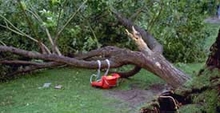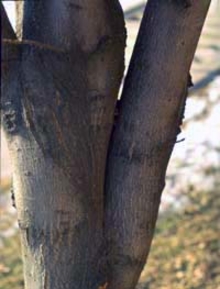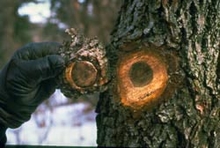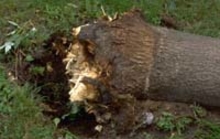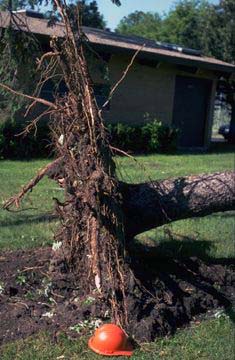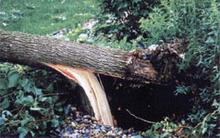Quick facts
- Healthy trees have a better chance of surviving storm damage.
- Natural tree imperfections can make them prone to damage.
- Cuts or wounds on trees can make them more vulnerable to insects and diseases.
- Homeowners can care for and repair minor damage, but hire a tree care professional to take care of more severe problems.
In the upper Midwest, wind and ice storms are common and often cause tremendous damage to individual trees and urban forests.
These storms can cause weakly attached branches to separate and rip trees apart. Trees with stem girdling roots or inadequate root systems may blow over or break off at the ground line.
Whatever the case, these effects can cause personal and property damage.
Causes of tree weakness
The key to preventing tree damage is to correct potential problems before storms strike. Read more about the common problems that can be corrected, below.
City foresters and tree care professionals can help you solve tree care problems.
Trees may suffer from several natural form imperfections that lead to damage under storm conditions.
Inclusion of bark at branch unions is a common weak point in trees. Branch unions should have a rough, protruding branch bark ridge where the branches meet. Without this proper union, branches or leaders have a tendency to separate during storm situations.
Trees may also have co-dominant leaders. This occurs when a tree has two or more branches or stems that are trying to become the center-point of the tree.
Co-dominant leaders typically exhibit inclusion at their unions. Some species that are notorious for having included branch unions and co-dominant leaders are:
- European mountain ash
- Green ash
- Hackberry
- Boxelder
- Willows
- Red maple
- Amur cherry
- Silver maple
- Littleleaf linden
Proper pruning at planting and throughout a tree's life can correct tree form problems. See Pruning trees and shrubs.
Decay is the natural degradation of tree stem, branch and root tissue.
- Decayed tissue is very weak and is the most common contributor to tree failure.
- Location and extent of decay within a tree makes a difference in a tree's potential for failure.
- Decay located within a single branch is not always a critical situation since weak branches can easily be removed.
- Decay located within the main part of the trunk can be seriously dangerous.
How to determine strength loss within a branch or stem:
- For every 3 inches of branch or stem diameter, solid wood should comprise at least 1 to 1.5 inches.
- Less than 1 to 1.5 inches of solid wood can indicate a branch or stem that is more likely to fail during a storm.
Maintenance
You can prevent or stop decay by using good maintenance practices.
- Avoid mechanical damage, including wounds from lawnmowers, grass trimmers and poor pruning.
- Don't pile mulch against the stem as this can lead to stem girdling roots and other unhealthy root systems.
- Avoid over watering the soil around trees as this can encourage shallow root systems, stem girdling roots and unstable trees. See tree watering recommendations.
- Be careful when using staking equipment. Wires that are too tight around stems can girdle and weaken stems.
Learn how to properly prune trees or hire a tree care professional to prune them. Poor pruning practices can encourage decay or the formation of weak branches.
- Don't flush cut or prune too close to the lead branch or trunk.
- Don't leave long stubs.
- Don't "top" or strip bark when pruning.
When mulching:
- Apply a 3-6 inch layer of coarse mulch, spread to form a 4-6 foot diameter circle around the tree.
- Keep the mulch material from direct contact with the tree trunk.
Staking equipment that is not properly installed or is left attached to the tree too long will damage stem tissue and encourage decay.
- Never attach staking wires or ropes to tree stems.
- Use wide, padding materials around the tree stem and connect these materials to the tree wires or ropes.
- There are several types of padding available to buy, but strips of carpeting, old belts or inner tubes also work well.
- Regularly inspect and adjust staking or guying materials on a tree for increased stem growth. Don't wait more than a year between adjustments.
Stem girdling roots are roots at or below the soil surface that partially or completely encircle the trunk of the tree. Over time, they begin to stress the health of the tree, including the root system.
The girdling roots eventually cause compression of the lower trunk, creating a weak point that is often the point of failure in high wind storms.
Many stem girdling root problems can be prevented by root pruning pot bound trees before planting and planting all trees at the correct depth–the first branch roots just below the soil surface. See Planting and transplanting trees and shrubs.
Some trees that have a tendency to form stem girdling roots are:
- Green ash
- Norway maple
- Silver maple
- Poplars
- Littleleaf linden
- Red maple
Note:
Trees that are native to floodplain areas (elms, maples, etc.) tend to form "stem" roots where they are frequently buried by floodplain material. These trees commonly form encircling roots when planted in cities, particularly when they are planted too deep.
Common site problems that may contribute to tree failure
- Shallow soils.
- Compacted clay soils.
- Saturated soils.
- Confined rooting areas.
- Inappropriate species for the location (such as large trees in small boulevard strips).
Most site problems are directly or indirectly related to lack of oxygen reaching the roots of the trees. When oxygen is lacking, root systems suffer and trees become unstable.
It is important to know your site situation, including soil types and rooting volume, before trees are selected and planted.
- Don't plant large trees that require well-drained soil on these sites.
- Use smaller trees or trees native to wet sites such as black alder and larches.
- Fix soil problems by aerating, adjusting drainage or amending the soil.
- Plant trees that mature to less than 40 feet in height if boulevards are less than 10 feet wide.
Small trees for boulevard sites
| Botanical Name | Common Name | Height | Comments |
|---|---|---|---|
| Acer tataricum ssp. ginnala | amur maple | 20-30' | Lightly scented May flowers are followed by double serrated dark colored leaves with lighter undersides; excellent fall color; hardy, adaptable; grown as a free-form clump, standard, or a well-groomed hedge; self-seeds. |
| Amelanchier laevis | Alleghany serviceberry | 15-25' | Minnesota native; large flowers; excellent red fall color; delicious edible purple fruits attract birds in summer. |
| Maackia amurensis | amur maackia | 12-20' | Good drought tolerance; adaptable small tree with a rounded crown; shiny patched bark sheds; lovely flowers; post-flowering pods; foliage emerges with a silvery cast; very slow early growth. |
| Carpinus caroliniana | bluebeech, ironwood or musclewood | 20-30' | Highly tolerant of and adaptable to difficult city conditions, even a bit of shade; Minnesota native; interesting steely blue-tinged bark; lovely red fall foliage. |
| Chionanthus virginicus | white fringe tree | 12-20' | Adaptable to salt and difficult conditions once established, worth the extra care needed initially; "hairy" young branches; fragrant white flowers; shiny deep-green foliage and winter buds provide winter interest. |
| Corylus americana | filbert or hazelnut | 8-15' | Large shrub or small tree; unique early spring catkins; nuts attract wildlife; nice foliage. |
| Cotinus obovatus | American smoketree | 20-30' | Underused and under-appreciated, this small tree bears round leaves that turn brilliant scarlet or purple in fall; tolerant of a variety of soil types. |
| Hamamelis virginiana | common witch hazel | 10-20' | Under-appreciated Minnesota native bears unusual bright yellow flowers in late fall on very dark brown branches; bright green foliage is slightly hairy and fragrant when crushed. |
| Malus hybrids | crabapple | 15-25' | Tough and hardy in Minnesota; scab can be a conspicuous foliar disease, look for resistant varieties; many flower colors provide vivid displays; various shades of green foliage and winter interest with yellow or red fruit. |
| Phellodendron amurense | amur cork tree | 20-35' | Excellent salt, compaction and dry soil tolerance; rounded canopy; irregular growth form; deeply furrowed gray-black bark and deep green shiny foliage; use male selections; can naturalize in wooded areas. |
| Syringa reticulata | Japanese tree lilac | 15-25' | Long-lived and cold tolerant; scented ivory flowers are an early summer hallmark; interesting winter seed pods. |
| Viburnum lentago | nannyberry | 12-18' | Native to Minnesota; multi-stemmed, can be grown as a standard; tolerant of most soil types once established; showy white flowers and multicolored fruit. |
Trees for compacted sites
| Botanical Name | Common Name | Height | Comments |
|---|---|---|---|
| Abies balsamea | balsam fir | 40-60' | Flat, fragrant needles, upright cones. |
| Acer rubrum | red maple | 50-70' | Round crown, transplants readily, grows much better on moist sites. |
| Acer saccharinum | silver maple | 45-75' | Oval crown with pendulous branches, transplants well, fast growth |
| Betula nigra | river birch | 40-70' | Peeling cinnamon-brown bark, often multi-stemmed |
| Celtis occidentalis | hackberry | 40-60' | Vase-like habit, easily transplanted, very adaptable. Slow to establish. |
| Fraxinus nigra | black ash | 40-70' | Large black buds, 'Fallgold' recommended for fall color. |
| Fraxinus pennsylvanica | green ash | 40-60' | Fast growth, deep shade, broad rounded form, seedless varieties. |
| Larix laricina | larch, tamarack | 40-70' | Native, deciduous conifer, yellow fall color, few pests |
| Malus hybrids | crabapple | 15-25' | Excellent variety in flower, fruit and foliage, and habit. |
| Picea mariana | black spruce | 30-70' | Spire-like conical habit with flaky brown cones. |
| Populus deltoides | eastern cottonwood | 80-100' | Open, irregular mature habit, fast growth, seedless 'Siouxland' recommended. |
| Quercus bicolor | bicolor oak | 60-70' | Resistant to oak wilt, yellow fall color, prefers acidic soil. |
| Salix amygdaloides | peachleaf willow | 30-40' | Long, fragrant leaves. |
| Salix nigra | black willow | 30-60' | Small- to medium-sized tree with orange twigs. |
| Thuja occidentalis | northern white cedar, arborvitae | 40-50' | Scale-like leaves, broad pyramidal form; 'Techny' recommended |
Preventing tree loss from storm damage
Trees that are properly planted and kept healthy are much more likely to weather a storm.
The conditions of the planting site are as important as the plant. Consider soil type and drainage, available water and sunlight, exposure to drying winds and other factors. Matching the needs of the plant to the site increases the plant’s performance and longevity.
The location of the planting site in relation to other trees and objects such as buildings, fences, etc. will affect temperature and moisture conditions. The amount of protection provided by individual microclimates can affect plant hardiness.
Planting too deep may be the most common planting mistake that leads to tree failure. The first set of roots should be just below the soil surface.
See Planting and transplanting trees and shrubs.
More information on caring for trees and shrubs and selecting trees and shrubs.
Take a tree inventory
By keeping track of the trees on your property and their condition, preventing storm damage is much easier.
- Create a list of key trees and key problems.
- Key trees are those that are most important to the property.
- Key problems are those that are most likely to damage or weaken those key trees.
- Check key trees regularly.
- When minor damage occurs, correction (such as pruning or wound painting on oaks during oak wilt season) may prevent damage from spreading throughout the tree.
- If extensive damage has occurred, take immediate corrective action to prevent further damage.
Watering, fertilizing, pruning and protecting trees against winter damage and wounding are all important for maintaining tree health. Healthy trees have a much better chance of surviving storm damage.
When trees are stressed, they become more susceptible to problems such as decay and damage from diseases or insects. These can weaken trees and make them more likely to be destroyed by high winds and flooding.
Pruning either corrects problems or creates them.
- Poor pruning can create places for decay to enter and increase the severity of wounds.
- Done correctly, pruning wounds should close over naturally, keeping decay from starting and expanding in the wound area.
- A general rule for pruning wounds: the smaller, the better.
Mulching, planting trees in landscaped beds, and even staking can give trees the necessary protection from mechanical injury.
- Wounds from lawnmowers and grass trimmers can cause areas of decay in trees.
- Cars, snowplows, staples, and any stacked materials that wound stems and branches can cause long-term damage in a short time.
Treating tree damage after a storm
There are things a homeowner can do to correct the minor damage that storms inflict.
Before trying to treat any major damage yourself, consider hiring a tree care professional. Except for pruning small branches and straightening slightly leaning small trees, it's best to consult an arborist.
- Small branches that have been damaged extensively should be removed to the next branch, but never cut off the branch collar.
- Storm damage that leaves a large tear where a limb came down should be pruned smooth by removing jagged and protruding wood.
- Do not remove large, heavy limbs with a single cut. If a branch is too heavy to support with one hand, a three-cut method should be used.
- Use proper pruning techniques to safely remove broken branches. See Pruning trees and shrubs.
For minor uprooting of smaller trees (shorter than 25-ft.), straightening and guying are both options if correction takes place immediately after damage has occurred.
- When staking an uprooted tree, be sure that the roots remain covered and moist.
- Stakes should be placed evenly around the tree and attached securely without pulling on the tree.
- Thin rope or wire should not be used against the trunk of the tree.
- Remove torn bark to reduce entry sites for diseases and insects or for aesthetic purposes.
- Split, cracked, torn branches should be removed to points of no damage.
- Don't remove bark from areas beyond the damage already present.
- When pruning branches or repairing wounds, it is usually unnecessary to paint the wounds.
- The exception is during oak wilt season (April through July).
- During this period, wounds made on oaks should be painted immediately with a latex paint or shellac to deter insects carrying the oak wilt disease fungus.
- See Oak wilt in Minnesota.
- Cabling and bracing are most effective as preventative measures and provide extra support for weakly attached branches or stems.
- Cabling and bracing are frequently used following storm damage.
- Only trained professionals should perform these installations.
- Most tree care companies will provide this service.
- See How to hire a tree care professional.
Possibly the most important question to address when evaluating storm damage is whether to hire a tree care professional or arborist to do the work.
- If you need a chainsaw or ladder to do the pruning,
- If there are any downed and potentially energized lines in the area of the tree,
- If you are wondering if the tree is worth saving, you need an arborist.
In any situation where there is the potential for personal or property damage (broken limbs hanging high in the tree or unsupported branches hanging over sidewalks), it is very important to immediately call your city forestry department or a reputable tree care company to remove the potential danger.
Find a list of certified arborists in Minnesota through the Minnesota Society of Arboriculture.
Contact your city forester or county Extension office for more information on branch or tree removal from boulevards and public spaces.
Reviewed in 2018


